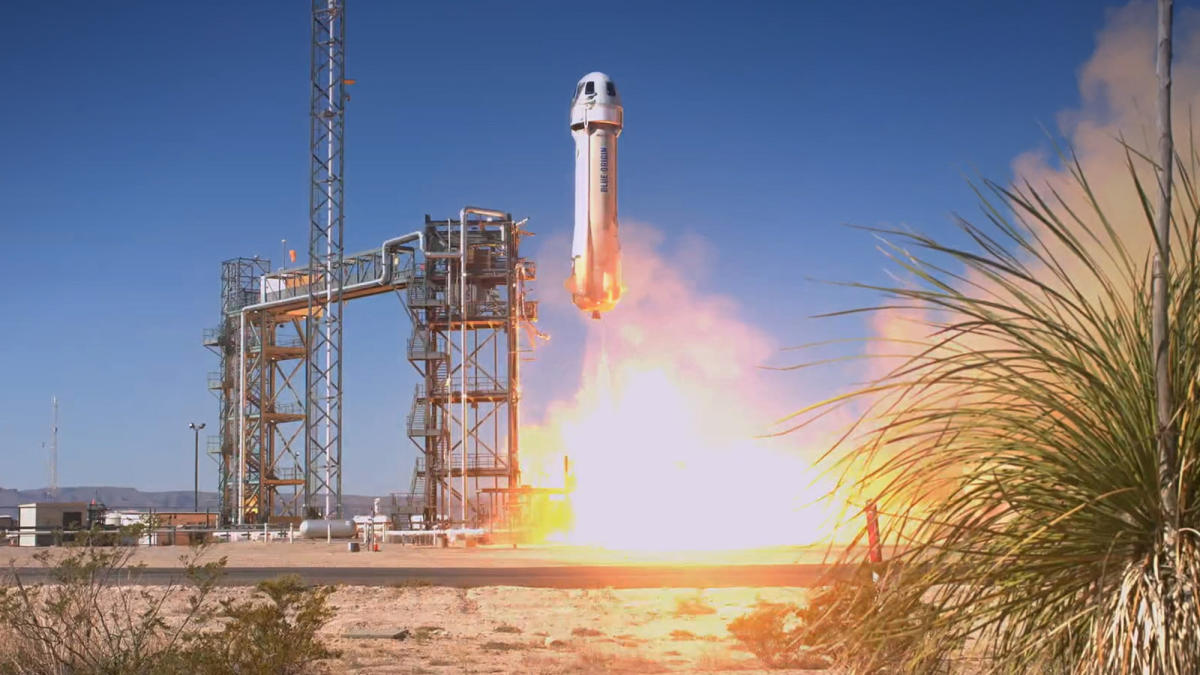A massive chunk of a Blue Origin rocket’s nose cone washed up on the shore of a Bahamian island near a tourist destination. In Europe, flaming debris from a SpaceX launch vehicle streaked across the German sky, and what appears to be a fuel tank may have landed on a company’s property in Poland.
And that’s just this week.
The incidents are unrelated to the SpaceX Starship rocket that exploded midair during a test flight in January, raining debris near Turks and Caicos, where residents said they are still working to clean up the detritus from beaches, roadways and bays.
That situation raised questions about safety standards for test flights of unproven launch vehicles that travel over population centers.
But this week’s two space debris-related events in the Bahamas and Europe point to how successful rocket launches can also leave their mark on Earth.
They also highlight how the rise in the number of rockets taking off any given week has increased the likelihood that space junk will find its way back to populated areas.
From sky and shore
According to the European Space Agency, junk falls to our planet from space all the time — though most of it is blown to smithereens while plunging back into Earth’s thick atmosphere at thousands of miles per hour.
“Satellites and rocket parts of moderate size re-enter almost daily, while small-size tracked space debris objects re-enter even more frequently,” the agency said.
The SpaceX rocket part that streaked through the European skies this week was a rare occurrence, however. The debris came from the second stage of a Falcon 9 rocket that had carried out a routine mission.
The rocket took off from California on February 1, hauling a batch of satellites for SpaceX’s Starlink network, which beams internet connectivity from space. But while the primary mission to deliver satellites to space went well, the rocket’s upper stage — or the portion that lights up after reaching space to finish off a mission — did not complete a controlled splashdown in the middle of the ocean as is typical, according to Jonathan McDowell, an astrophysicist at the Harvard–Smithsonian Center for Astrophysics.
Based on preliminary information, the Falcon 9 rocket part was dragged out of orbit in an uncontrolled manner, which is likely why the vehicle appeared to reenter Earth’s atmosphere over Europe and crash-land this week.
Photos and video posted to social media show the rocket upper stage, which disintegrated into pieces as it plunged back from space, rushing through the sky.
Headed into work early Wednesday, a German train driver captured the event in a video after spotting “a very strange constellation of flying lights in the sky.”
“I was wondering at first, what kind of flying objects that could be,” the train driver, identified as Ludi, said in an email to CNN. “I was thinking of falling stars, comets, meteors or even missiles.”
The European Space Agency confirmed and shared Ludi’s footage.
The Polish Space Agency also addressed the ordeal in a statement, noting that the rocket part’s trajectory would have carried it toward Poland.
Images of what appears to be an intact fuel tank that may have landed near Poznań, Poland, also began circulating on social media and in local news reports.
Polish hardware and supply business Elektro-Hurt shared photos of the discarded rocket part — lying against a chain-link fence on its property — calling it an “extraordinary delivery.”
It is not yet clear why the Falcon 9’s upper stage did not complete a regular, controlled descent into the ocean.
SpaceX did not respond to a request for comment, though CNN confirmed from the Federal Aviation Administration that officials from the company are working to verify whether the debris originated from the Falcon 9.
The FAA, which licenses commercial rocket launches, told CNN that the agency did not begin an investigation into a possible mishap with the Falcon 9 in the immediate aftermath of the February 1 launch.
But SpaceX has 90 days to report an anomaly, or rocket malfunction, according to the FAA.
Potential space debris dangers
In an interview last month, Marlon Sorge — executive director of the Center for Orbital and Reentry Debris Studies at The Aerospace Corporation, a federally funded research center — said that space debris can be hazardous.
Space debris can pose risks to people on the ground who come into contact with the object, particularly if toxic fuels are involved. But that’s only part of the danger, Sorge said, noting that even nontoxic propellants are “still volatile, like gasoline.”
Tanks may be especially dangerous to handle, according to Sorge: “If they’re weakened, you touch them, they blow up,” he added.
“It’s not that it’s (always) a death sentence to get close to one of these things,” Sorge said of space debris. “Mostly they’re probably OK, but it is potentially risky. And it’s not worth people getting injured.”
Part of New Glenn’s nose cone
The piece of Blue Origin debris that washed up in the Bahamas is not a sign of a rocket launch gone awry. Rather, the debris — a large chunk of a rocket’s nose cone that features the signatures of Blue Origin employees — appears to have been discarded as expected from the company’s New Glenn rocket during its maiden flight on January 16.
Debris from the payload fairing, or nose cone, of Blue Origin's New Glenn rocket appears on a beach in the Bahamas after washing ashore. - Judy Fortenberry
The nose cone, or payload fairing, is designed to shield satellites during launch and break away from the vehicle after it reaches the vacuum of space. And while SpaceX tries to recover fairing pieces as they fall back toward Earth, Blue Origin’s New Glenn was expected to dispose of its nose cone in the ocean.
It appears to be what happened before the waves forced a floating piece of the hardware onto the shores of an island in the Bahamas, according to a social media post on Monday.
“Does anyone have any muscle power to pull this space ship debris up onto the beach,” the post reads, calling it a hazard and a “historical find.”
Blue Origin confirmed that debris from the New Glenn fairing washed up in the Bahamas.
“Some minor debris from New Glenn’s fairing washed ashore in Abaco, Bahamas, over the weekend,” the company said in a statement to CNN on Tuesday. “The fairing’s landing in the sea was planned and expected. We have sent a team out to recover the pieces.”
Blue Origin included contact information for members of the public who may encounter space debris. People can reach out by phone at 321-222-4355 or by email [email protected].
NASA can also be reached at 202-358-0001. And SpaceX has its own debris recovery email: [email protected].
Signatures from Blue Origin employees are visible on part of the New Glenn nose cone, which was jettisoned shortly after the rocket took flight on its maiden voyage in January. - Judy Fortenberry
Risk of injury called ‘extremely remote’
SpaceX has grappled with debris landing in populated areas even before the Starship mishap in January.
In 2021, for example, a Falcon 9 fuel tank landed on a farm in Washington state. And the following year, a piece of a SpaceX Dragon capsule was recovered in Australia.
A string of other incidents have also made headlines, from a mysterious ring-shaped object that crashed into a village in Kenya in late December to garbage from the International Space Station striking a family home in Florida last year.
But space agencies and regulators maintain that space debris poses a minuscule risk to populated areas.
“Pieces that survive have only very rarely caused any damage on the ground. The risk of any satellite reentry causing injury is extremely remote,” the European Space Agency said in a statement. “The annual risk of an individual human being injured by space debris is under 1 in 100 billion. In comparison, a person is about 65,000 times more likely to be struck by lightning.”
For more CNN news and newsletters create an account at CNN.com

 German (DE)
German (DE)  English (US)
English (US)  Spanish (ES)
Spanish (ES)  French (FR)
French (FR)  Hindi (IN)
Hindi (IN)  Italian (IT)
Italian (IT)  Russian (RU)
Russian (RU)  18 hours ago
18 hours ago

























Comments